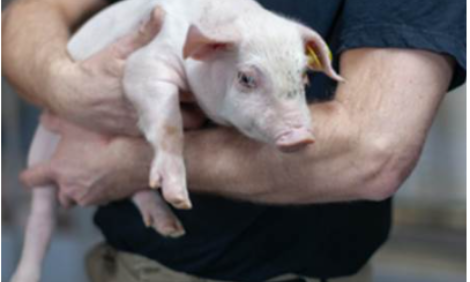



Managing Large Group Grow-Finish Pigs
By Banff Pork - This report contains 3 articles taken from the Banff Pork Seminar 2004 Proceedings concerning management of grow-finish pigs. |
Contents
Considerations for Large Group Housing of Finishing Pigs
Managing Grow-Finish Pigs in Large Groups
Managing Large Group Grow Finisher Pigs
Considerations for Large Group Housing of Finishing Pigs
Lee Whittington, Prairie Swine Centre Inc and Keith Schneider, Vaccine & Infectious Disease Organization.
Introduction
Many questions have been asked about facility design and management of grower finisher hogs in large groups. This document is designed to evaluate our current knowledge of large group housing (LGH), and is based on the experience of researchers, equipment manufacturers and our members. The document is constantly evolving as new information is obtained. For the most recent version please check the website www.vido.org.
Fully Slatted Floors versus Partially Slatted Floors
We fully recognize that producers will consider converting existing partially slatted floor barns to large group housing. Many of the points in this paper can be applied to partially slatted floors. We decided that we should maintain the focus on a fully slatted floor system, the most typical system used in Canada for LGH. It was also felt, that except for challenges with dunging patterns, most aspects of fully and partially slatted floors would apply to large group housing.
To read this article please click here (PDF)

Managing Grow-Finish Pigs in Large Groups
By Harold W. Gonyou, Prairie Swine Centre Inc.
Introduction
Conventional management of grow-finish pigs has been in groups of 30 or fewer pigs in a pen. Group size has often been determined after selecting a feeder type, and thus groups of 24-28 for a two-space wet/dry feeder have been common in the past decade.
However, larger operations have resulted in hundreds of animals being weaned simultaneously and moved into nursery and eventually grow-finish facilities. Even after sorting these animals by sex, it is possible on many farms to have several hundred males and females available for placement at one time. Keeping animals in groups of 100 or more has the potential of reducing housing costs, specifically penning, and giving producers more flexibility in building design and management.
In the past, professional judgment would have urged caution in adopting large group management. Concerns were expressed about growth performance, variability, morbidity and vices. Because these opinions were formed when large groups meant that pigs from several farms and weeks were mixed together, we should now question the advice to keep groups small. In addition to being assured that good productivity is possible, we must also learn how best to manage pigs in large groups. As the industry moves toward this change in systems, we have encountered challenges, but also great potential in new management approaches.
To read this article please click here (PDF)

Managing Large Group Grow Finisher Pigs
Rocky Morrill, Peace Pork Inc. Sunrise Pork Producers.
Introduction
The purpose of this presentation is to provide a practical case study for those considering building either a new swine unit with group housing and sorter or renovating an existing operation. The case study is based on Peace Pork Inc.’s actual experience in installing over 50 automatic sorters in finisher barns. Of the 50 installed, 16 were installed in a barn that was converted from partially slatted floors to the fully slatted system necessary to accommodate the sorters.
As feeding units become much larger and the jobs much more specific or single tasked, employees that run finishing barns have a daunting task. Peace Pork Inc. operations include two 8,000 head finishing barns that are operated by a single crew of four. The two barns have a separation of growth of about two months. Therefore, the crew is weighing and shipping pigs constantly. When the last stragglers are exiting one barn they are starting to weigh the heaviest pigs in the next barn. Throw in some washing and receiving and this is the life of a large finishing barn pig farmer. To hire individuals to work in this environment is challenging to say the least.
When the concept of using group housing and an electronic sorter to weigh and group hogs became known, we realized that this could help us in a number of areas. Although saving the backs of employees is a good goal to have, there still needs to be other advantages to warrant such an investment.
To read this article please click here (PDF)
Source: Paper presented during the 2004 Banff Pork Seminar Procedings









